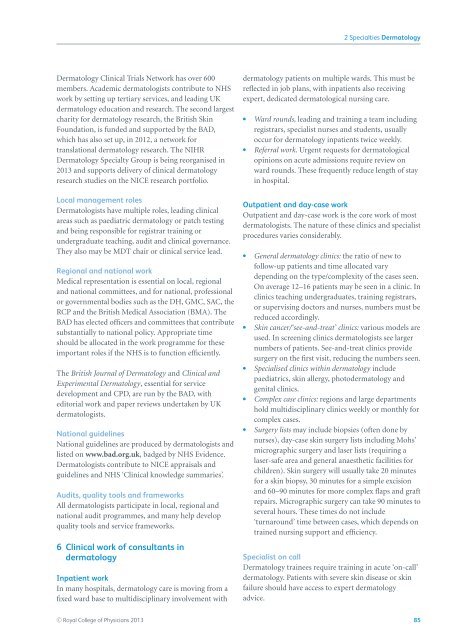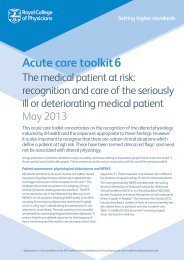Consultant physicians working with patients - Royal College of ...
Consultant physicians working with patients - Royal College of ...
Consultant physicians working with patients - Royal College of ...
You also want an ePaper? Increase the reach of your titles
YUMPU automatically turns print PDFs into web optimized ePapers that Google loves.
2 Specialties DermatologyDermatology Clinical Trials Network has over 600members. Academic dermatologists contribute to NHSwork by setting up tertiary services, and leading UKdermatology education and research. The second largestcharity for dermatology research, the British SkinFoundation, is funded and supported by the BAD,which has also set up, in 2012, a network fortranslational dermatology research. The NIHRDermatology Specialty Group is being reorganised in2013 and supports delivery <strong>of</strong> clinical dermatologyresearch studies on the NICE research portfolio.Local management rolesDermatologists have multiple roles, leading clinicalareas such as paediatric dermatology or patch testingand being responsible for registrar training orundergraduate teaching, audit and clinical governance.They also may be MDT chair or clinical service lead.Regional and national workMedical representation is essential on local, regionaland national committees, and for national, pr<strong>of</strong>essionalor governmental bodies such as the DH, GMC, SAC, theRCP and the British Medical Association (BMA). TheBAD has elected <strong>of</strong>ficers and committees that contributesubstantially to national policy. Appropriate timeshould be allocated in the work programme for theseimportant roles if the NHS is to function efficiently.The British Journal <strong>of</strong> Dermatology and Clinical andExperimental Dermatology, essential for servicedevelopment and CPD, are run by the BAD, <strong>with</strong>editorial work and paper reviews undertaken by UKdermatologists.National guidelinesNational guidelines are produced by dermatologists andlisted on www.bad.org.uk,badgedbyNHSEvidence.Dermatologists contribute to NICE appraisals andguidelines and NHS ‘Clinical knowledge summaries’.Audits, quality tools and frameworksAll dermatologists participate in local, regional andnational audit programmes, and many help developquality tools and service frameworks.6 Clinical work <strong>of</strong> consultants indermatologyInpatient workIn many hospitals, dermatology care is moving from afixed ward base to multidisciplinary involvement <strong>with</strong>dermatology <strong>patients</strong> on multiple wards. This must bereflected in job plans, <strong>with</strong> in<strong>patients</strong> also receivingexpert, dedicated dermatological nursing care. Ward rounds, leading and training a team includingregistrars, specialist nurses and students, usuallyoccur for dermatology in<strong>patients</strong> twice weekly. Referral work. Urgent requests for dermatologicalopinions on acute admissions require review onward rounds. These frequently reduce length <strong>of</strong> stayin hospital.Outpatient and day-case workOutpatient and day-case work is the core work <strong>of</strong> mostdermatologists. The nature <strong>of</strong> these clinics and specialistprocedures varies considerably. General dermatology clinics: the ratio <strong>of</strong> new t<strong>of</strong>ollow-up <strong>patients</strong> and time allocated varydepending on the type/complexity <strong>of</strong> the cases seen.On average 12–16 <strong>patients</strong> may be seen in a clinic. Inclinics teaching undergraduates, training registrars,or supervising doctors and nurses, numbers must bereduced accordingly. Skin cancer/‘see-and-treat’ clinics: variousmodelsareused. In screening clinics dermatologists see largernumbers <strong>of</strong> <strong>patients</strong>. See-and-treat clinics providesurgery on the first visit, reducing the numbers seen. Specialised clinics <strong>with</strong>in dermatology includepaediatrics, skin allergy, photodermatology andgenital clinics. Complex case clinics: regions and large departmentshold multidisciplinary clinics weekly or monthly forcomplex cases. Surgery lists may include biopsies (<strong>of</strong>ten done bynurses), day-case skin surgery lists including Mohs’micrographic surgery and laser lists (requiring alaser-safe area and general anaesthetic facilities forchildren). Skin surgery will usually take 20 minutesfor a skin biopsy, 30 minutes for a simple excisionand 60–90 minutes for more complex flaps and graftrepairs. Micrographic surgery can take 90 minutes toseveral hours. These times do not include‘turnaround’ time between cases, which depends ontrained nursing support and efficiency.Specialist on callDermatology trainees require training in acute ‘on-call’dermatology. Patients <strong>with</strong> severe skin disease or skinfailure should have access to expert dermatologyadvice.C○ <strong>Royal</strong> <strong>College</strong> <strong>of</strong> Physicians 2013 85

















